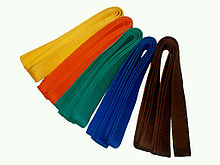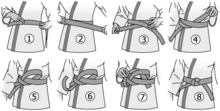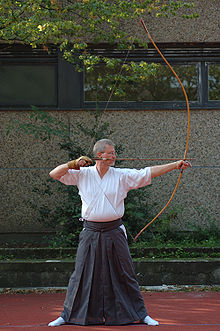- Obi (martial arts)
-
 Obis for budō. The colours range from yellow to brown corresponding to judo kyū levels from 9th to 1st.
Obis for budō. The colours range from yellow to brown corresponding to judo kyū levels from 9th to 1st.
Many Japanese martial arts feature an obi as part of their exercise outfit. These obis are often made of thick cotton and are about 5 cm wide. The martial arts obis are most often worn in the koma-musubi knot (square knot); in practice where hakama is worn, the obi is tied in other ways.
In many martial arts the colour of the obi signifies the wearer's skill level. Usually the colours start from the beginner's white and end in the master's black, or red and white.
Contents
Aikidō
Unlike in many other martial arts, adult practitioners of aikidō do not wear coloured obis[1], though in some schools different colour codes have been formed,[1] especially for children. The children's obis range from white for beginner level to 5th kyū, other colours for the rest of the kyū levels, and black for levels 1st dan and up.[2]
In some aikidō schools, wearing a hakama is a privilege earned by reaching the first dan level. In other schools, all practitioners may wear a hakama. After taking up using a hakama, the colour of obi does not matter since it will be covered by the hakama.[2]
Example of colour range in aikidō
Below is a typical example of obi colours per level in aikidō[1]:
Level Obi colour 6th kyū yellow 5th kyū orange 4th kyū green 3rd kyū blue 2nd and 1st kyū brown 1st-3rd dan black 4th-9th dan black and red, or
white and red10th dan red However, aikidō schools worldwide may use their own systems with little reference to other schools save the use of a black belt for at least some dan grades.
Atarashii naginata
The outfit used for atarashii naginata practice includes a hakama that covers the obi. The obi is always white; its colour has no significance beyond simply blending in with the white keikogi worn when practicing the art.
Iaidō
The outfit worn to iaidō practise includes a hakama, which is worn over the top of the obi, which fastens the keikogi. The obi colour has no meaning in iaidō[3], and is usually chosen to blend in with the kimono or hakama worn by the practitioner.
Jōdō
The outfit used for jōdō practise includes a hakama that covers the obi. The colour of the obi has no significance.
Jūdō
Below are the colours of obis worn for jūdō practise. Junior practitioners have a different colour range.[4] There are also other colour ranges used worldwide.
Level Obi colour beginners red 10th kyū white 9th kyū yellow 8th and 7th kyū orange 6th and 5th kyū green 4th and 3rd kyū blue 2nd and 1st kyū brown 1st - 5th dan black 6th and 7th dan red and white 8th - 10th dan red Shōdan-ho brown and black
("temporary black")1st – 5th dan black 6th dan and higher red and white Jūjutsu
The colours for obis used for jūjutsu practise range as follows[5]:
Level Obi colour beginners red 10th – 8th kyū red 7th kyū white with
a red stripe6th kyū yellow 5th kyū orange 4th kyū green 3rd kyū blue 2nd kyū violet 1st kyū brown Shōdan-ho brown and black
("temporary black")1st - 5th dan black 6th dan and higher red and white Jūkendō
The outfit used for Jūkendō practise includes a hakama that covers the obi. The colour of the obi has no significance.
Karate
Wadō-ryū
The obis used in the wadō-ryū karate school range in colour as follows[6]:
Level Obi colour beginners white 10th kyū white 9th kyū white with
a yellow stripe8th kyū yellow 7th kyū orange 6th kyū green 5th kyū blue 4th kyū violet 3rd - 1st kyū brown 1st dan and higher black Shōtōkan
The obis used in the shōtōkan karate school range in colour as follows[7]:
Level Obi colour 9th kyū orange 8th kyū red 7th kyū yellow 6th kyū green 5th kyū violet 4th kyū violet with
a white stripe3rd kyū brown 2nd kyū brown with
a white stripe1st kyū brown with
two white stripes1st - 5th dan black 6th dan and higher black, or
red and whiteKendō
The outfit used for kendō practise includes a hakama that covers the kendogi. An obi is optional; if worn, its colour has no significance.[8]
Kyūdō
The outfit used for kyūdō practise includes a hakama that covers the obi. The colour of the obi has no significance.
Tankendō
The outfit used for tankendō practise includes a hakama that covers the obi. The colour of the obi has no significance.
References
- Bennett, Gary (1997). Aikido techniques & tactics. Human Kinetics Publisher. ISBN 0-88011-598-X.
- Goodman, Fay (1998). The Ultimate Book of Martial Arts. Lorenz Books. ISBN 1-85967-778-9.
Notes
Categories:- Japanese martial arts terms
- Keikogi
Wikimedia Foundation. 2010.


